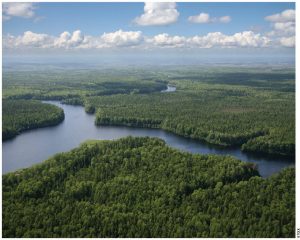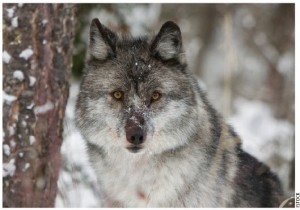The Canadian boreal forest is one of the world’s most important breeding areas for migratory birds, with 1 billion to 3 billion individual birds from at least 300 species known to regularly breed there. Approximately 30 percent of all shorebirds (7 million) and 30 percent of all landbirds (1 billion to 3 billion) that breed in the United States and Canada do so within the boreal. The section of the boreal forest that sits over the tar sands region of Alberta is part of the forest that is rapidly being fragmented by oil development. As much as 34 to 66 percent of the Canadian boreal forest — up to 438 million acres (177 million hectares)— may no longer be intact. In Alberta, 86 percent of the boreal forest is no longer considered intact. This puts valuable bird habitat at risk.

The section of the boreal forest underlain by tar sands in Alberta is critical not only as traditional breeding habitat for its 22 million to 170 million birds, but also as a globally important flyway for a great abundance and diversity of wetland-dependent birds. Unfortunately, the rapidly expanding industrial oil extraction operations in Alberta’s boreal forest place these birds increasingly at risk on a massive scale.
The boreal forest is a critical ecosystem
The tar sands deposits lie in the boreal plains ecozone, which covers 183 million acres (74 million hectares) and extends across British Columbia, Northwest Territories, Alberta, Saskatchewan, and Manitoba. Forest cover is predominantly coniferous, and black spruce, white spruce, jack pine, and tamarack are principal species. Hardwoods, particularly trembling aspen, white birch, and balsam poplar, are well represented and are often mixed with conifers. This is one of the most productive forest areas in western Canada.
Approximately 35 percent of the boreal plains is composed of wetlands, including bogs, fens, swamps, marshes, and shallow open-water ponds. Some areas of the boreal plains have 85 to 95 percent wetland ground coverage, and these areas can stretch as wide as 120,000 acres (48,500 hectares). These extensive wetland and water areas combine with complex uplands to create a diverse mosaic of bird habitats. Most of these wetlands are connected through surface and groundwater hydrology and are highly susceptible to damage from tar sands development.
Using satellite imagery, scientists documented that less than 20 percent of the 182 million acre (73 million hectare) boreal plains ecozone (the portion of the southern boreal extending from the eastern foothills of the Canadian Rockies to south-central Manitoba) remains in large, intact forest landscapes. Between 1990 and 2000, one million acres (406,000 hectares) of the southern boreal of Saskatchewan and Manitoba and more than 5.9 million acres (2.4 million hectares) of the boreal of Quebec were disturbed by human-caused influences, including forestry, road-building, and other infrastructure development.

The region of the boreal that covers northeastern Alberta is a biologically rich area that is known to support at least 292 species of breeding birds, including most of the declining species and 65 bird species of conservation concern. While boreal forest habitat supports densities of breeding birds ranging from 0.64 to 4.86 breeding individuals per acre depending on habitat type, studies of breeding birds in northern Alberta have found some of the highest densities anywhere within the boreal, often exceeding 4.86 birds per acre.
The area is also an important migratory corridor for large numbers of ducks, geese, cranes, and shorebirds. Many of these birds use the Peace-Athabasca Delta directly to the north (and downstream) or portions of the river system near agricultural areas along the western and southern edges of the tar sands as staging areas. Surveys in the 1970s estimated up to 1.4 million waterbirds use the delta in fall migration. Limited aerial surveys of shorebirds in the Delta in 1999 found single-day counts of 11,000 and 14,000 birds. In some years, the bulk of the world’s population of birds such as Ross’s goose has migrated through the boreal forest. In other years, they are joined by large numbers of white-fronted geese, lesser sandhill cranes, and central flyway populations of Canada geese. Aerial surveys of the Peace-Athabasca Delta in late June and July 1998-2001 found as many as 400,000 molting ducks, coot, and geese. In August and September in those same years, numbers peaked at 800,000 individuals.
The boreal forest supports large numbers of songbirds, shorebirds, and waterfowl
The boreal supports more than 25 percent of the global populations of 149 bird species and the bulk of some of North America’s most abundant bird species. An estimated 38 percent (26 million) of all of the waterfowl of Canada and the United States breed in the boreal. More than 208 million dark-eyed juncos, 116 million white-throated sparrows, 96 million yellow-rumped warblers, 102 million American robins, and 73 million Swainson’s thrushes are among the abundant birds that rely on the Canadian boreal for breeding every year.
Virtually all species of boreal nesting birds also make use of parts of the boreal during migration. Some birds rely more on the boreal for migratory stop-over habitat than for breeding or wintering. For example, the white-rumped sandpiper does not breed in the boreal but makes extensive use of boreal wetlands during fall and spring migration. Other shorebirds such as the pectoral sandpiper that have insignificant portions of their breeding range in the boreal, are also highly reliant on boreal wetlands during migration. Many waterfowl species also regularly migrate through a large part of the boreal.
Within the tar sands, surveys at or over tailings ponds and small natural lakes have regularly documented tens of thousands of waterbird migrants. For example, a spring 2003 survey documented more than 16,000 birds, largely geese, ducks, and shorebirds; however, radar suggested that at least four times that many (64,000) may have actually passed over, as many birds may go visually undetected, especially at night. At Gordon Lake, south of Fort McMurray, one-day counts as high as 5,600 have been documented during the spring, and estimates during fall migration of up to 100,000 ducks have been reported. Kearl Lake has had single-day spring counts as high as 2,700 birds, and of more than 1,000 birds at McClelland Lake. A study in 1972-73 in Syncrude’s tar sands lease area found over 1,000 waterbirds present each day during spring and fall migration. The same study documented 1,500 ducks using a section of the Athabasca River on a single day during spring migration. A 1984 study, also on the Syncrude lease, reported more than 18,000 geese observed passing over during fall migration.
Similarly, at Utikuma Lake on the southwest edge of the tar sands, aerial surveys documented over 100,000 waterbirds of 29 species using the lake including up to 20,000 gulls, 8,000 canvasbacks, 5,000 lesser scaup, 4,900 bufflehead, 4,500 western grebes, and 4,000 mallards. The Peace-Athabasca Delta has also been estimated to support as many as 130,000 breeding waterfowl — birds that must pass over or near the tar sands during migration. Among these breeding birds have been as many as 20,000 mallards, over 15,000 lesser scaup, nearly 10,000 canvasbacks, 7,000 common goldeneye, and 5,000 bufflehead.
Approximately 94 percent of individual birds migrate out of the boreal after breeding, heading to other countries in the Western hemisphere, or even outside the hemisphere. More species winter in the United States (the lower 48 states) than in any other country or region — a total of 204 species, or approximately 63 percent of boreal breeding birds.
Tar sands development puts some of the world’s most at-risk birds in danger
Recent global assessments have shown that an ever-increasing number of bird species are at risk. The International Union for Conservation of Nature (IUCN) red list of threatened species now includes more than 10 percent of the world’s birds in some conservation concern category, and BirdLife International has documented a doubling of the extinction rate of birds in the last century. In North America alone, more than 400 bird species are listed as being of conservation concern on one or more conservation lists, and there are more than 70 North American species on the IUCN Red List.
Some of North America’s most rapidly declining birds are among those most reliant on the boreal. Waterfowl like greater and lesser scaup have declined by about 150,000 birds a year since the late 1970s, and the three scoter species have dropped by more than 50 percent since the 1950s. Another wetland bird species, the horned grebe, has declined by 60 percent since the late 1960s.
Two of the species showing the most severe documented declines are species that are highly reliant on the boreal forest — the lesser yellowlegs and the rusty blackbird. Both have seen drops of more than 90 percent over the last 40 years. Other species have had less severe but still steep declines, including the olive-sided flycatcher (70 percent decline), Canada warbler (80 percent decline), bay-breasted warbler (70 percent decline), evening grosbeak (70 percent decline), white-throated sparrow (30 percent decline), and the short-billed dowitcher (50 percent decline in some populations).
Many of the shorebird species that have been documented migrating through the boreal forest where tar sands are being developed are birds of conservation concern that have shown significant declines and/or have relatively small populations that place them at higher risk. Shorebird species that have been documented in the region include black-bellied plover and American golden-plover, lesser yellowlegs, sanderling, semipalmated sandpiper, white-rumped sandpiper, pectoral sandpiper, stilt sandpiper, and red-necked phalarope.
The only wild, migratory population of the highly endangered whooping crane nests solely in and near northeastern Wood Buffalo National Park to the north of today’s open-pit mines. Birds from this population migrate over the boreal tar sands region and occasionally stop over at wetland locations.
Jeff Wells, PhD, is with the Boreal Songbird Initiative. He was the lead author and co-authored this report with Susan Casey-Lefkowitz, Natural Resources Defense Council, Gabriela Chavarria, PhD, Natural Resources Defense Council and Simon Dyer, Pembina Institute. Visit www.nrdc.org/wildlife/borealbirds.pdf for the complete, cited report.





